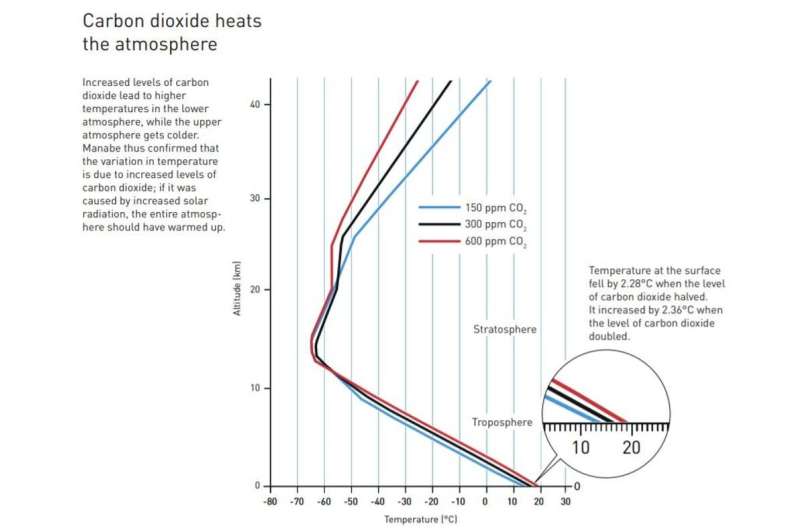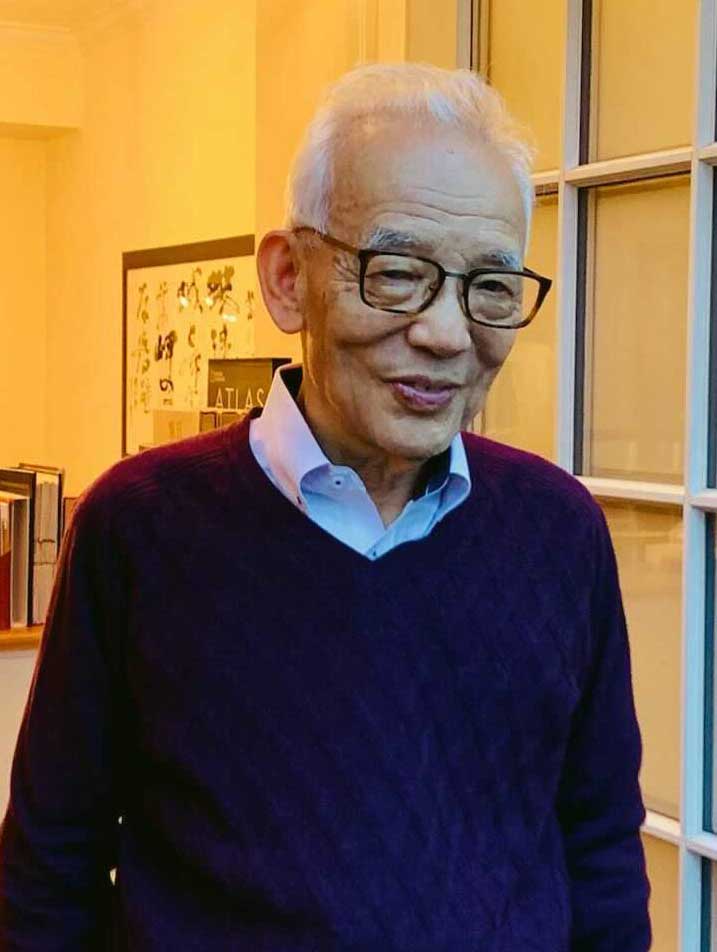NOBEL PRIZE WINNER IN PHYSICS
The most influential climate science paper of all time

After the second world war, many of Japan's smartest scientists found jobs in North American laboratories. Syukuro (Suki) Manabe, a 27-year-old physicist, was part of this brain drain. He was working on weather forecasting but left Japan in 1958 to join a new research project by the US Weather Service to develop a numerical model that could be used to study the climate.
Working alongside Joseph Smagorinsky, the Geophysical Fluid Dynamics Laboratory's visionary first director, Manabe led a team of computer programmers to add missing physics to the lab's weather model. Even the best computers in the world at the time were far less powerful than today's mobile phones. So to get the model to work, Manabe needed to make the physics as simple as possible. This meant making a range of coding approximations to quantify how the air exchanged heat and water vapor with the land, ocean and ice.
This climate model development—the first of its kind—was an ambitious 20-year project that ultimately earned Manabe a share of the 2021 Nobel prize in physics. The key paper came mid-way through this period: Manabe and Wetherald (1967).
Manabe is typically modest about intentions behind the work and from reading its title, "Thermal Equilibrium of the Atmosphere with a Given Distribution of Relative Humidity", you might be forgiven for thinking it could be a bit dull. Yet the Nobel committee, myself and the hundreds of colleagues around the world that voted it the most influential climate science paper of all time, would beg to differ.
In trying to simplify the code, Manabe and his colleague Richard Wetherald wanted to know the minimum number of discrete levels to use in his model atmosphere. They also wanted to know which greenhouse gasses it was necessary to include in the model to adequately represent the way temperatures vary with altitude, as these gasses absorb heat emitted from the Earth's surface, but at different levels. Their three-dimensional climate model was too computer-intensive to run these model tests, so they had to build a simpler one-dimensional model. They wanted to simulate how radiation and clouds interact to redistribute heat and water vapor through the atmosphere.
The bulk of the paper concerns itself with building the simple model and doing these tests. But they also do two other experiments in the paper to quantify how greenhouse gas might alter climate. And this is where the breakthrough occurred: they found they had built the perfect model to accurately estimate how human activities could alter the Earth's surface temperature.
Their first such climate-change experiment wasn't to look at the role of carbon dioxide, but was to look at the effects of water vapor injected high into the stratosphere from a potential fleet of supersonic jets, as this and a possible nuclear winter were the immediate concerns of the time. However, their Table 5 goes down in history as the first robust estimate of how much the world would warm if carbon dioxide concentrations doubled. Manabe and Wetherald estimated 2.36℃ of warming, not far off today's best estimate of 3℃.
Earlier attempts to estimate the warming from carbon dioxide increases had floundered, as scientists struggled to work out how water vapor, the most important greenhouse gas in the atmosphere, would respond as the Earth warmed. Manabe and Wetherald's simple model could accurately redistribute water vapor in a way that real deep clouds do, with water vapor broadly increasing in concentration up to a certain level of humidity. This increase was found to amplify the warming from carbon dioxide by around 75%. This water vapor feedback estimate has also stood the test of time.
Manabe, working with various colleagues, went on to write many more seminal climate modeling papers. He set the foundation for today's global climate modeling efforts. The physics was beguilingly simple so his models could run on these early computers. Yet, by being simple, the results could be understood and tested. His application of these simple models to the pressing problems of today was insightful.
After graduating with a degree in physics over 30 years ago, I chose a career in atmospheric science over particle physics. I always worried about how my applied physics was viewed by mainstream physics colleagues. With a Nobel prize in physics under our discipline's belt, it gives me and climate modeling colleagues the credibility and recognition we have yearned for: climate science is real science.
October 5th, 2021
Today, Syukuro “Suki” Manabe, 90, was named among the winners of the 2021 Nobel Prize in Physics for his groundbreaking climate science achievements. His pioneering research in the 1960s laid the foundation for how scientists perceive the Earth’s climate and how human actions continue to influence it. Starting in the 1960s, Manabe, a senior meteorologist in Atmospheric and Oceanic Sciences (AOS) based at Princeton University, developed the first three-dimensional models of the atmosphere while working at NOAA‘s Geophysical Fluid Dynamics Laboratory (GFDL) along with founding director Joseph Smagorinsky.
Their research went on to predict what would happen to the globe as carbon dioxide built up in the atmosphere.
Manabe shares the Nobel Prize in physics this year with fellow climate scientist Klaus Hasselmann of the Max Planck Institute for Meteorology, Hamburg, Germany; and Giorgio Parisi of the Sapienza University of Rome, Italy. The decades of combined work by Manabe and Hasselmann presented the first physical modeling of Earth’s climate, which reliably predicted global warming. Parisi’s work revealed “the interplay of disorder and fluctuations in physical systems from atomic to planetary scales,” according to the Nobel Prize press release.
Manabe remains active today as a NOAA affiliate at Princeton University’s Forrestal campus.
“The timing of this award couldn’t be better as world leaders head to the 26th UN Climate Change Conference meeting, armed with the most recent update of climate science to underpin their commitments,” said Ko Barrett, NOAA Research Senior Advisor for Climate. “Society owes a debt of gratitude to Professors Manabe and Hasselmann for their fundamental discoveries about the climate system that have spurred 50 years of research and understanding about this existential threat. And at NOAA, we are forever grateful for all that Professor Manabe contributed to climate science at NOAA and helped mentor the new generation of climate scientists. ”
According to the Nobel committee, scientists had shown for decades how carbon dioxide traps heat, but Manabe’s work put specifics and prediction into that general knowledge. It allowed scientists to eventually show how climate change will worsen and how fast depending on how much carbon pollution is released.
GFDL Director V. “Ram” Ramaswamy said much of Manabe’s historic work took place while associated with the NOAA lab at Princeton. In a combined statement with Stephan Fueglistaler, director of Atmospheric and Oceanic Sciences (AOS) and NOAA’s Cooperative Institute for Modeling the Earth System (CIMES), the two celebrated Manabe’s achievements.
“We congratulate and applaud Suki for being awarded the extremely high honor of the 2021 Nobel Prize in Physics,” according to their statement. “Suki is a remarkable pioneer in the development and application of computational models to understand climate and climate change. His research has been central to explaining the changes in climate due to increases in greenhouse gases. His modeling and science have enabled the construct of the Paris Agreement on climate, with his numerical models proving remarkably prescient in the prediction of the patterns of climate change.”
In a Nobel Prize press release, the award committee praised how Manabe demonstrated to the world how increased levels of carbon dioxide in the atmosphere lead to increased temperatures at the surface of the Earth.
“In the 1960s, he led the development of physical models of the Earth’s climate and was the first person to explore the interaction between radiation balance and the vertical transport of air masses. His work laid the foundation for the development of current climate models,” the release states.
Born in 1931, Manabe received a doctorate from the University of Tokyo in 1958 and went to the United States to work at the General Circulation Research Section of the U.S. Weather Bureau, now GFDL, continuing until 1997. He worked until 2001 at the Frontier Research System for Global Change in Japan serving as director of the Global Warming Research Division. In 2002, he returned to the United States as a visiting research collaborator in the collaborative GFDL – Princeton AOS program.

Highlights of Manabe’s Career at GFDL
1958-1963: Research Meteorologist, General Circulation Research Section, U.S. Weather Bureau
1963-1997: Senior Research Meteorologist, Geophysical Fluid Dynamics Laboratory, NOAA
1968-1997: Lecturer with Rank of Professor, Program in Atmospheric & Oceanic Sciences, Princeton University
1967: Meisinger Award, American Meteorological Society
1967: Fellow, American Geophysical Union
1987: Second Half Century Award, American Meteorological Society
1990: Member, U.S. National Academy of Sciences
1992: Rossby Medal, American Meteorological Society
1993: Revelle Medal, American Geophysical Union
1992: First recipient of Blue Planet Prize, Asahi Glass Foundation
1997: Honorary Member, American Meteorological Society
1997: Fellow, American Association for the Advancement of Science
1997: Volvo Environment Prize, Volvo Environment Prize Foundation
1997: Minister’s Award, Japan Ministry of Environment
No comments:
Post a Comment